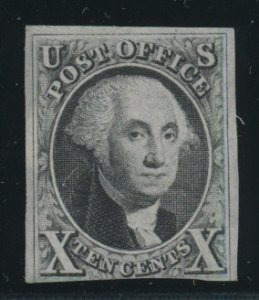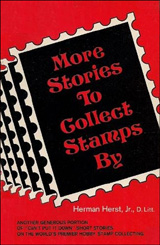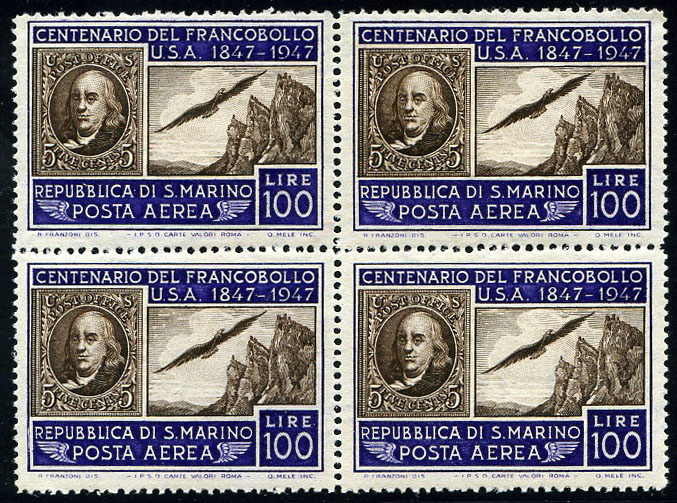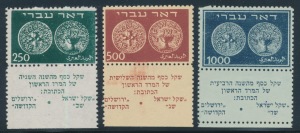 Philately has always been a cold weather hobby. Its popularity nation to nation and region to region has always increased south to north with the highest concentrations of serious collectors where it is the coldest and darkest. The reasons are clear: a cup of hot chocolate, a stamp album, and some new additions to mount are a nice way to spend a blustery winter's evening. But, there are other reasons, too. Paper doesn't keep so well in warm, sticky climates, and literacy and reading rates, which are good predictors of philatelic interest, are higher in northern countries. We can see collector rates getting higher and higher the further from the equator that we move. Philately has always been a major hobby in Scandinavia, but even within countries the rate of stamp collecting increases as you move from the warmer parts of the country to the colder. In Germany, probably the most philatelically active nation, far more collectors live in the Northern, colder part of the country than the Southern.
Philately has always been a cold weather hobby. Its popularity nation to nation and region to region has always increased south to north with the highest concentrations of serious collectors where it is the coldest and darkest. The reasons are clear: a cup of hot chocolate, a stamp album, and some new additions to mount are a nice way to spend a blustery winter's evening. But, there are other reasons, too. Paper doesn't keep so well in warm, sticky climates, and literacy and reading rates, which are good predictors of philatelic interest, are higher in northern countries. We can see collector rates getting higher and higher the further from the equator that we move. Philately has always been a major hobby in Scandinavia, but even within countries the rate of stamp collecting increases as you move from the warmer parts of the country to the colder. In Germany, probably the most philatelically active nation, far more collectors live in the Northern, colder part of the country than the Southern.
Monthly Archives: December 2017
- Posted December 29, 2017Read more »
- Posted December 28, 2017Read more »The stamp business used to have what economists call high barriers to entry. It took a lot of knowledge, a lot of capital, and years of advertising and satisfying customers to build a good mailing list and a good stamp business. When the Internet became the preferred method of buying and selling in philately, there was considerable worry that old time stamp dealers would lose their competitive edge and that eBay and Stampwants would, overnight, make any seller a competitor of dealers who had spent decades building their sales networks.It has worked out somewhat differently. It is true that today anyone can be a seller with immediate access to the worldwide philatelic community. Twenty years ago only a few professionals had access to selling stamps to more than
- Posted December 26, 2017Read more »
 Throughout philatelic history, writers have been predicting the next great philatelic area or specialty that will take off in price. Predictions are usually founded on one of two criteria that predict the supposed increase in popularity that the stamps will undergo. Either the economy of the country will take off creating a pool of desperate collectors eager to buy the older issues that you should have put away (if only you had listened to the prognosticator), or there is some intrinsic not fully understood rarity factor that collectors will ultimately discover which will make them eager to buy stamps that you (had you listened to the prognosticator) should have put away in quantity. The problem with predictions is that they tend to be very accurate in hindsight, and we tend to forget all the ones that haven't panned out. For the last fifty years, Brazil was always going to be the next best country. The economy was going to boom, and 120 million Brazilian collectors would enter the
Throughout philatelic history, writers have been predicting the next great philatelic area or specialty that will take off in price. Predictions are usually founded on one of two criteria that predict the supposed increase in popularity that the stamps will undergo. Either the economy of the country will take off creating a pool of desperate collectors eager to buy the older issues that you should have put away (if only you had listened to the prognosticator), or there is some intrinsic not fully understood rarity factor that collectors will ultimately discover which will make them eager to buy stamps that you (had you listened to the prognosticator) should have put away in quantity. The problem with predictions is that they tend to be very accurate in hindsight, and we tend to forget all the ones that haven't panned out. For the last fifty years, Brazil was always going to be the next best country. The economy was going to boom, and 120 million Brazilian collectors would enter the - Posted December 25, 2017Read more »Most philatelists, and especially most stamp dealers, see a dichotomy between traditional stamp collecting and the collecting of stamps on covers, which has come to be called postal history. Years ago, the best dealers and collectors of covers and postal history came up from the ranks of traditional philately. It was only after someone knew the stamps of a particular area and had collected and studied them for years that they would begin to study the use of those stamps and add covers to their collections. This fundamental way that most collectors began their hobby began to change around 1970 when collectors and dealers started to specialize in covers without any real knowledge of the stamps that franked their covers. This change occurred because increasing philatelic popularity had made prices so high that creating traditional stamp collections was too daunting for many collectors, and they moved into the hobby as cover collectors before having any real grounding in stamps.
- Posted December 22, 2017Read more »
Stamp certification never provides absolute certainty to stamp buyers. Expert committees in the United States are very clear that they offer only an opinion, not a guarantee. Their legal boilerplate, which every owner signs when he commits his stamps or covers to the expertization process, stipulates that the opinion is just that, an opinion, and that if the stamp or cover should later prove to be a forgery or repaired, well (and this is couched in a bunch of legal mumbo-jumbo), tough luck. Grading standards change as does the equipment available for determining the genuine from the fake. For many years an ultraviolet light was the tool of choice for determining whether or not an early US classic was mint or had a cleaned pen cancel. Later technology with magnification and light has made that way of determining
the genuiness of great rarities seem - Posted December 21, 2017Read more »
Stamps have been written about since they first started being collected (for over 150 years now) so any avid philatelic reader has millions of philatelic words to brighten his cold winter evenings. Over time, readers have realized that stamp writing comes in four major types. Each collector has his favorite type and writers rarely write in more than one of these different philatelic genres.
 The first major type of stamp writing, the largest in terms of words written and books and articles published in the more high-brow journals, is technical writing. The first issue of the London Philatelist, published in 1892, had as one of its first articles a long study on the stamps of New South Wales. Articles about plating
The first major type of stamp writing, the largest in terms of words written and books and articles published in the more high-brow journals, is technical writing. The first issue of the London Philatelist, published in 1892, had as one of its first articles a long study on the stamps of New South Wales. Articles about plating - Posted December 19, 2017Read more »Throughout the Nineteenth Century, postal officials around the globe had one paranoia in common: they feared that postal patrons were soaking used stamps off envelopes, washing the cancellations, and then reusing the stamps. Philatelists who have studied thousands of stamps from the period have found scant evidence of this fraud. But that didn't keep postal authorities from devising more and more detailed plans to discourage such illegal reuse. The anti-reuse hysteria reached its apex with the grilled issues of 1867.Grills are tiny cuts made in the paper of a stamp. The stamps were printed, gummed, and, before the perforation process, fed into a device that looks like a printing press but which has metal cutting heads that make a small group
- Posted December 18, 2017Read more »The great stamp speculation of the late 1970s, which saw worldwide stamps at least double in price in less than five years, had a precursor in the mid 1960s. The European stamp speculations that were then the driving force in worldwide price increases had a basis in reality. After World War II, Europe was devastated. The economies of Germany and Italy were shattered, and the economic infrastructure of these countries destroyed. People first needed food, clothing, and shelter; providing this for themselves filled Europe's time in the decade after the War. As the economies of Western Europe improved, collectors began to try to find the post-war issues that they had been unable to afford when they had come out. They looked mainly for the higher values of sets and Airmail denominations for use in the United States. Earlier stamps were also in short supply. Many fine stamp collections had been damaged or destroyed in the War, and in the post war period many fine collections had been sold
- Posted December 18, 2017Read more »
 Every kid in the 1950s and 1960s began collecting stamps the same way. We started with a Harris or Minkus worldwide album. Mine was the Statesman Deluxe, which had spaces for over 25,000 stamps. Next up the ladder was the Citation album, which had spaces for over 50,000 stamps, and to which I aspired. What made these albums interesting (and what made philately the social hobby that it was in the 1950s and 1960s for children) was the fact that these albums had illustrations; Harris and Minkus also marketed packets of 10,000 or 20,000 different stamps which contained many of the stamps that were illustrated in the album. Each packet contained not only many of the same stamps, but also many stamps that were different from one packet to the other. This meant that you and your friends could get together with your albums and trade stamps from your packets. Each of us were collecting from the same body of worldwide stamps, and it might be because such packets of worldwide stamps no longer
Every kid in the 1950s and 1960s began collecting stamps the same way. We started with a Harris or Minkus worldwide album. Mine was the Statesman Deluxe, which had spaces for over 25,000 stamps. Next up the ladder was the Citation album, which had spaces for over 50,000 stamps, and to which I aspired. What made these albums interesting (and what made philately the social hobby that it was in the 1950s and 1960s for children) was the fact that these albums had illustrations; Harris and Minkus also marketed packets of 10,000 or 20,000 different stamps which contained many of the stamps that were illustrated in the album. Each packet contained not only many of the same stamps, but also many stamps that were different from one packet to the other. This meant that you and your friends could get together with your albums and trade stamps from your packets. Each of us were collecting from the same body of worldwide stamps, and it might be because such packets of worldwide stamps no longer - Posted December 18, 2017Read more »The United States is probably the most difficult country to collect, no matter how you figure difficulty. If your measure of difficulty is cost, then US stamps win hands down; a complete collection of US stamps, only done once, would be worth near $20 million, many times the cost of any other single country. If your definition of difficulty is how hard it is to identify different major catalog numbers from one another, classic US philately has the crown there, too.
 No other country has turned minor plate varieties into major numbers like the Scott catalog has done.
No other country has turned minor plate varieties into major numbers like the Scott catalog has done. - Posted December 18, 2017Read more »
The world was very different in 1960 than it is today. The universe was only four billion years old, a considerable age but adolescent compared to the nearly 14 billion years astronomers think it is today. Black holes hadn't been theorized or discovered. There was less documentation to prove evolution, as DNA had only been worked out a few years before. No one had been to the moon. No one had color television sets. I Love Lucy hadn't been replaced by Snookie and J-Wow. Making a phone call meant sitting down in your home and dialing. There were no computers and Internet and philatelists reading articles like this would be holding newspapers in their hands. And mail meant stamps. The world around us is very different than it was when the Baby Boomers were kids.
But the stamp world has changed very little in the last fifty years. True, most collectors buy their stamps differently. Online sales - Posted December 18, 2017Read more »Probably nine out of ten philatelic forgeries were created in the nineteenth century. There were three primary reasons for this. First, stamps that were issued in the earliest period (before there were many stamp collectors) never existed in sufficient quantities in even the limited market by 1890. Second, early philatelic standards did not view forgeries the way we do today. Many early collectors were glad to have a “reproduction”, or a “reprint,” as they were euphemistically called, in their collection when they couldn't afford the genuine. And third, the consolidation of the German and Italian States in the late nineteenth century into the great nation states of Germany and Italy left twenty or so stamp issuing entities (that had issued many rare stamps that collectors desired) without government agencies to police counterfeits of their stamps. The stamps had been demonetized, and so, from a government point of view, counterfeits were a nuisance, not a revenue
- Posted December 18, 2017Read more »
Preprinted labels as collected by philatelists come in three broad categories: postage stamps, revenues, and Cinderellas. Postage stamps are collected by all philatelists. They are the major stamp issues of each country and are issued for the prepayment of postage. Postage Stamps are listed in many major worldwide catalogs. Collecting postage stamps has a long history and is very popular. Revenues are stamps that are issued to pay taxes, not postage. However,
- Posted December 18, 2017Read more »
 Like Germany, Japan was devastated as a result of WWII. American bombing had destroyed industrial production, and the war had killed a high percentage of young adult males. Many homes were in ruins, and the electric and telecommunications grid was annihilated. Like Germans, the Japanese are an energetic and frugal people, and by the 1960s, fifteen years after the end of hostilities, Japan had largely rebuilt and was on its way to reemerging as one of the industrial powers of the world. The Japanese poured their export earnings into technology and universities and infrastructure, but unlike the Germans, the Japanese never really got into stamps.
Like Germany, Japan was devastated as a result of WWII. American bombing had destroyed industrial production, and the war had killed a high percentage of young adult males. Many homes were in ruins, and the electric and telecommunications grid was annihilated. Like Germans, the Japanese are an energetic and frugal people, and by the 1960s, fifteen years after the end of hostilities, Japan had largely rebuilt and was on its way to reemerging as one of the industrial powers of the world. The Japanese poured their export earnings into technology and universities and infrastructure, but unlike the Germans, the Japanese never really got into stamps.
- Posted December 18, 2017Read more »
 Get a group of sixty year old doctors together, and you are sure to hear complaints about managed care and capitation and MBAs that get between doctors and patients. Lawyers have similar issues. People in the printing and publishing business lament the Internet. And independent booksellers now all seem to work for Barnes and Noble for $8 an hour. Every business and avocation has changed dramatically over the last thirty years. Philatelists, with our view of history, should be more understanding of this. Change has always affected all hobbies and occupations. Certainly the Internet and all that technology has opened up to us has dramatically changed our world. But have these changes been more dramatic than the changes that the electrification of the world between 1880 and 1920 caused? Are the changes now more overwhelming than how our lives were altered by the great transportation revolution of 1920-1960 which was facilitated by cars and planes? My daughter lives in California.
Get a group of sixty year old doctors together, and you are sure to hear complaints about managed care and capitation and MBAs that get between doctors and patients. Lawyers have similar issues. People in the printing and publishing business lament the Internet. And independent booksellers now all seem to work for Barnes and Noble for $8 an hour. Every business and avocation has changed dramatically over the last thirty years. Philatelists, with our view of history, should be more understanding of this. Change has always affected all hobbies and occupations. Certainly the Internet and all that technology has opened up to us has dramatically changed our world. But have these changes been more dramatic than the changes that the electrification of the world between 1880 and 1920 caused? Are the changes now more overwhelming than how our lives were altered by the great transportation revolution of 1920-1960 which was facilitated by cars and planes? My daughter lives in California. - Posted December 18, 2017Read more »
 There are three broad traits that philatelists share with each other. The first is inquisitiveness. Many very intelligent people are quite content with what they know. They do well in their professions and in their life, and their idle time is spent being entertained. Others, people who are receptive to our hobby, love to learn and know about things, and find information and facts interesting. They collect knowledge, and its an easy transition for them to collect stamps.The second trait that people with a philatelic predilection share is that they are savers. Sure, they have bank accounts as successful adults, often large ones, but they also had bank accounts when they were little pipsqueaks and always left aside a little for later even when
There are three broad traits that philatelists share with each other. The first is inquisitiveness. Many very intelligent people are quite content with what they know. They do well in their professions and in their life, and their idle time is spent being entertained. Others, people who are receptive to our hobby, love to learn and know about things, and find information and facts interesting. They collect knowledge, and its an easy transition for them to collect stamps.The second trait that people with a philatelic predilection share is that they are savers. Sure, they have bank accounts as successful adults, often large ones, but they also had bank accounts when they were little pipsqueaks and always left aside a little for later even when





